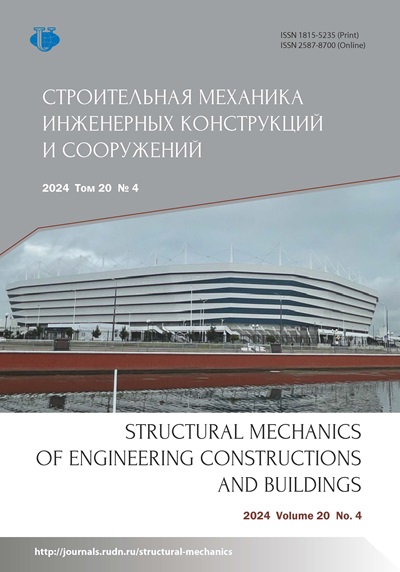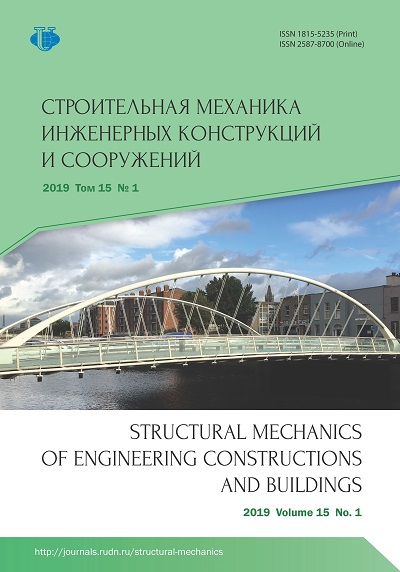Сравнение расчетных кривых балки с боковым крутильным изгибом с использованием AISC, EC и СП
- Авторы: Галишникова В.В.1, Гебре Т.Х.1
-
Учреждения:
- Российский университет дружбы народов
- Выпуск: Том 15, № 1 (2019)
- Страницы: 25-32
- Раздел: Расчет и проектирование строительных конструкций
- URL: https://journals.rudn.ru/structural-mechanics/article/view/20715
- DOI: https://doi.org/10.22363/1815-5235-2019-15-1-25-32
Цитировать
Полный текст
Аннотация
Цель исследования. Расчет на устойчивость является неотъемлемой частью проектирования стальных конструкций. Он очень важен для определения оптимального поперечного сечения стальных балок. Поперечное боковое выпучивание обычно происходит у балок, которые подвержены вертикальной нагрузке и теряют устойчивость из плоскости приложения нагрузок. Это является основным фактором при проектировании стальных конструкций и может привести к снижению несущей способности. Методы. Существуют различные методы расчета стальной балки на поперечное боковое выпучивание. Все нормы расчета по-разному подходят к исследованию поперечное-бокового выпучивания, в данной статье внимание сконцентрировано на трех из них. Первый метод предложен Американским институтом стальных конструкций (AISC), второй описан в Еврокоде (ЕС), третий приводится в российских строительных правилах (СП). Особое внимание уделено методам построения кривых для поперечного бокового выпучивания и определения их характеристик. Результаты. Нормы, разработанные Американским институтом стальных конструкций, рекомендуют рассматривать три режима потери устойчивости, зависящие от длины элементов ( Lb ). Однако ЕC и СП дают уменьшение XLT и предохраняют конструкцию от поперечного бокового выпучивания. В основном изгибная жесткость для поперечных сечений с высокими стенками согласно AISC выше, чем в ЕС и СП.
Об авторах
Вера Владимировна Галишникова
Российский университет дружбы народов
Автор, ответственный за переписку.
Email: galishni@gmail.com
доктор технических наук, директор департамента cтроительства Инженерной академии
Российская Федерация, 117198, Москва, ул. Миклухо-Маклая, 6Тесфалдет Хадгембес Гебре
Российский университет дружбы народов
Email: tesfaldethg@gmail.com
аспирант департамента строительства Инженерной академии
Российская Федерация, 117198, Москва, ул. Миклухо-Маклая, 6Список литературы
- Salmon C.G., Johnson J.E., Malh F.A. Steel Structures Design and Behavior: Emphasizing Load and Resistance Factor Design. 5th edition. 2009. Pp. 417–431.
- Bazant Z.P., Cedolin L. Stability of Structures: Elastic, Inelastic, Fracture and Damage Theories // World Scientific. 2010. 1009 p.
- Kalju L., Ivar T. Comparative study of the buckling of steel beams in Eurocode 3 and the Russian code // Journal of Constructional Steel Research. 2006. No. 62. Pp. 1290–1294.
- Trahair N.S. Buckling analysis design of steel frames // Journal of Constructional Steel Research. 2009. No. 65. Pp. 1459–1463.
- Rebekka W., Rolf K., Markus K. Lateral Torsional Buckling Behavior of Steel Beams – On the Influence of the Structural System // Structures. 2017. No. 11. Pp. 178 doi: 10.1016/j.istruc.2017.05.007
- Jan B., Miroslav B., Martin V., Jindřich M., Marcela K., Jiří P. Experimental Analysis of Lateral Torsional Buckling of Beams with Selected Cross-Section Types // Procedia Engineering. 2017. No. 195. Pp. 56–61.
- Galishnikova V.V., Pahl P.J. Analysis of frame buckling without sidesway classification // Строительная механика инженерных конструкций и сооружений. 2018. Т. 14. №. 4. С. 299–312.
- Quanwang L., Aming Z., Hao Z. A simplified method for stability analysis of multi-story frames considering vertical interactions between stories // Advances in Structural Engineering. 2016. Vol. 19. No. 4. Pp. 599–610.
- Claudio B.C. Structural Steel Design to Eurocode 3 and AISC Specifications. 2016.
- Khelil A., Larue B. Simple solutions for the flexural-torsional buckling of laterally restrained I-beams // Engineering Structures. 2008. No. 30. Pp. 2923–2934.
- Trahair N.S., Hancock G.J. Steel Member Strength by Inelastic Lateral Buckling // J. Struct. Eng., 2004. No. 130. Pp. 64–69.
- Ivan B., Jindřich M. Lateral-torsional buckling of beams of mono-symmetrical cross sections loaded perpendicularly to the axis of symmetry Theoretical analysis // Euro Steel. 2017. No. 2–3. Pp. 1086–1095.
- Merih K., Leroy G., Lorenzo M. Lateral-torsional buckling assessment of steel beams through a stiffness reduction method // Journal of Constructional Steel Research. 2015. No. 109. Pp. 87–100.
- Edgar W., Driver R.G., Heal T.W. Simplified approach to estimating the elastic lateral-torsional buckling capacity of steel beams with top-flange loading // Can. J. Civ. Eng. 2015. No. 42. Pp. 130–138.
- Trahair N.S. Flexural-Torsional Buckling of Structures. 2017. 352 p.
- Steel Construction Manual. 13th edition / American Institute of Steel Construction. 2011.
- White D.W., Asce M. Unified Flexural Resistance Equations for Stability Design of Steel I-Section Members: Overview // Journal of Structural Engineering. 2008. Vol. 134. No. 9. Pp. 1405–1424.
- Subramanian L.P., Jeong W.Y., Yellepeddi R., White D.W. Assessment of I-Section member LTB resistances considering experimental data and practical inelastic buckling design calculations, Structural Engineering // Mechanics and Materials Rep. 2016. No. 110.
- Zdeněk K. Elastic Lateral-Torsional Buckling of Simply Supported Hot-Rolled Steel I-Beams with Random Imperfections // Procedia Engineering. 2013. No. 57. Pp. 504–514.
- Park J.S., Young-Jong K. Flexural-Torsional Buckling of Stepped Beams Subjected to Pure Bending // KSCE Journal of Civil Engineering. 2004. Vol. 8. No. 1. Pp. 75–82.
- Guiul I.S., Petru M., Danciu A.D., Ciitiilin M. Lateral Torsional Buckling Resistance Of Steel Plate Girders According To Euronorms // The Eight International Conference “Bridges in Danube Basin. 2014.
- Gebre T.H., Negash N.A. The development of strength curve for compressive members using three different codes: 9 AISC, Euro Code and Russian steel construction) // Инженерные системы – 2018: труды научно-практической конференции с международным участием. 2018. С. 59–67.
- Mohammad Anwar-Us-Saadat, Mahmud A. The continuous strength method for lateral-torsional buckling of stainless steel I-beams // Thin-Walled Structures. 2018. No. 130. Pp. 148–160.
- Gardner L., Trahair N.S., Bradford M.A., Nethercot D.A. The Behaviour and Design of Steel Structures to EC3. 2008.
- Chiew S.P., Lee C.K., Jin Y.F., Cai Y.Q. Impact of Structural Eurocodes on steel and composite structures // The IES Journal Part A: Civil & Structural Engineering. 2014. Vol. 7. No. 1. Pp. 1–10.
- Galishnikova V.V., Gebre T.H., Al-Sabri S.A.M., Saffia-Doe O. Second order structural theory for the stability analysis of columns // Строительная механика инженерных конструкций и сооружений. 2018. Т. 14. № 3. С. 192–197.
- Badari B., Papp F. On Design Method of Lateraltorsional Buckling of Beams: State of the Art and a New Proposal for a General Type Design Method // Periodical Polytechnic Civil Engineering. 2015. Vol. 59. No. 2. Pp. 179–192.
- Yong D.J., Lopez A., Serna M.A. Beam-Column Resistance of Steel Members: A Comparative Study of AISC LRFD and EC3 Approaches // International Journal of Structural Stability and Dynamics. 2011. Vol. 11. No. 2. Pp. 345–361.
- BS EN 1993-1-1:2005. Eurocode 3: Design of steel structures. Part 1–1: General rules and rules for buildings / EC3 European committee for standardization. UK, British Standards Institution, 2005.
- Lindner J. Design of beams and beam columns, Technical University Berlin, Germany // Progress in Structural Engineering and Materials. 2003. No. 5. Pp. 38–47.
















